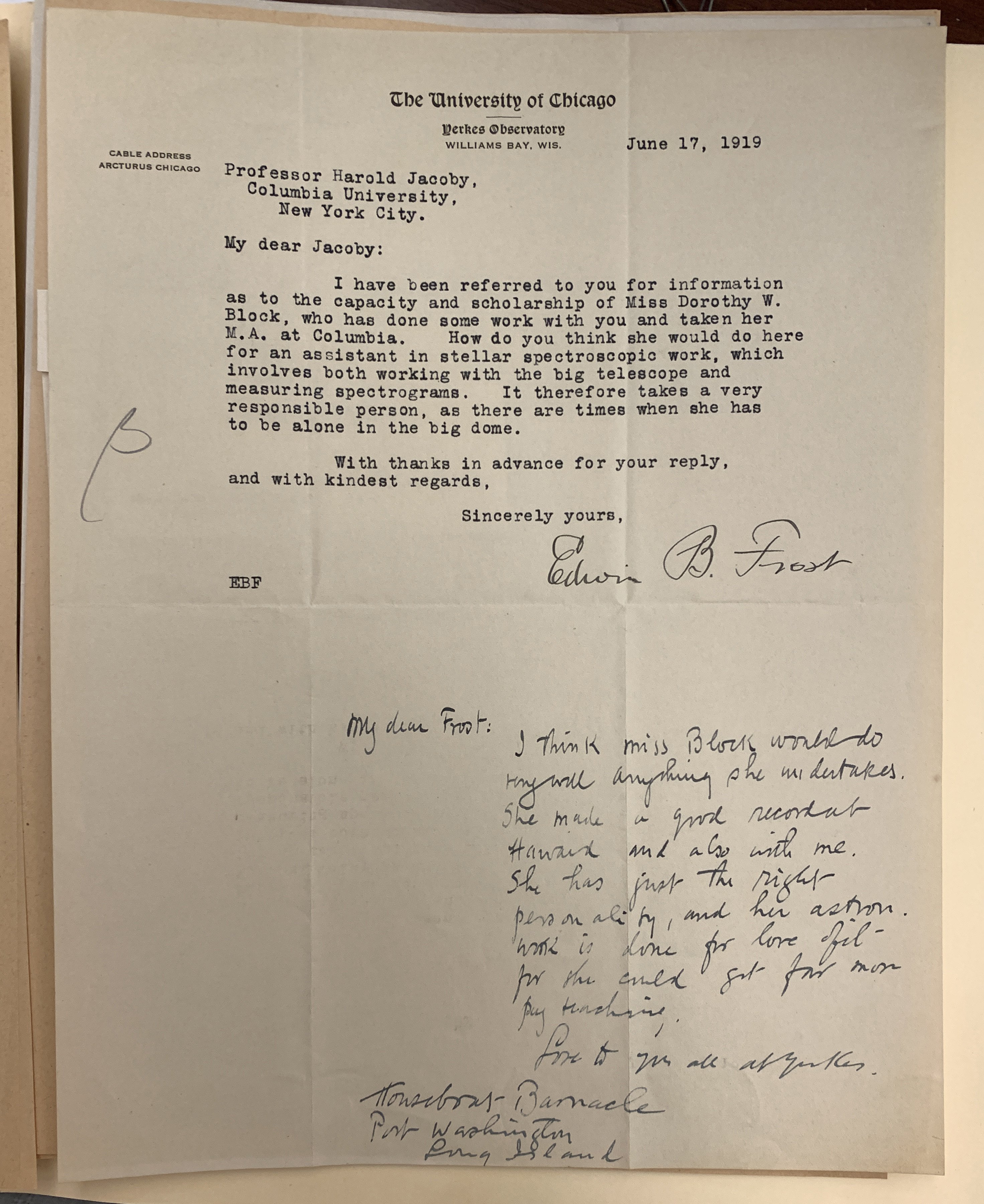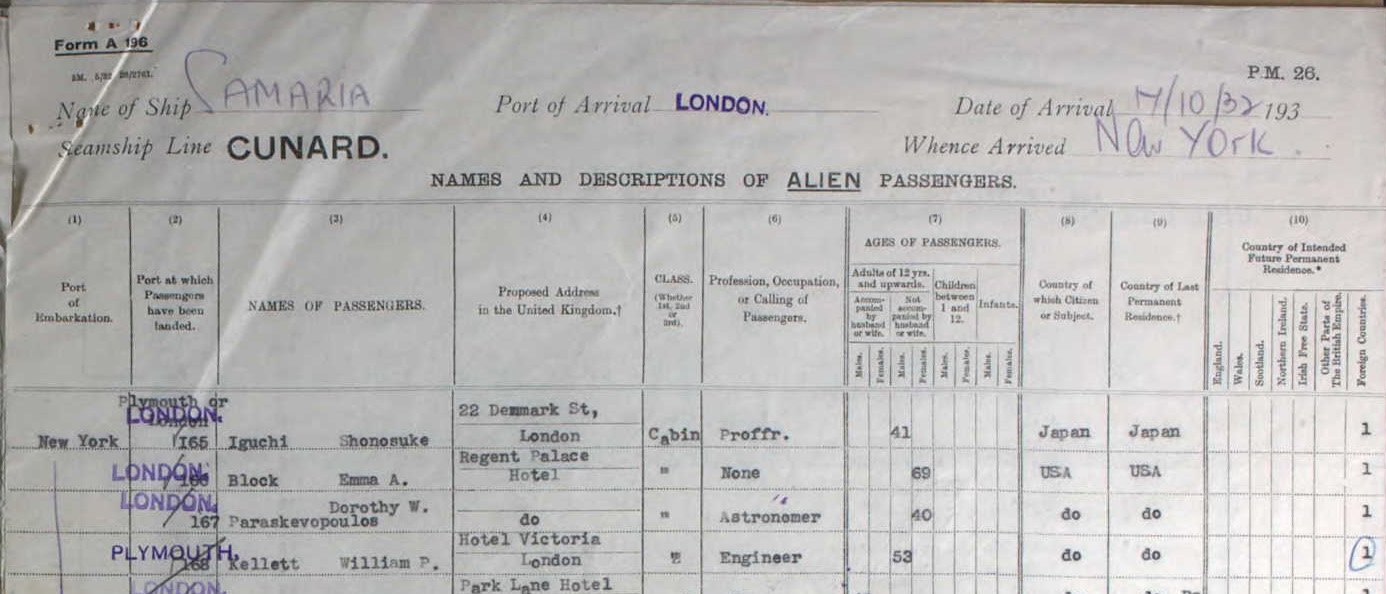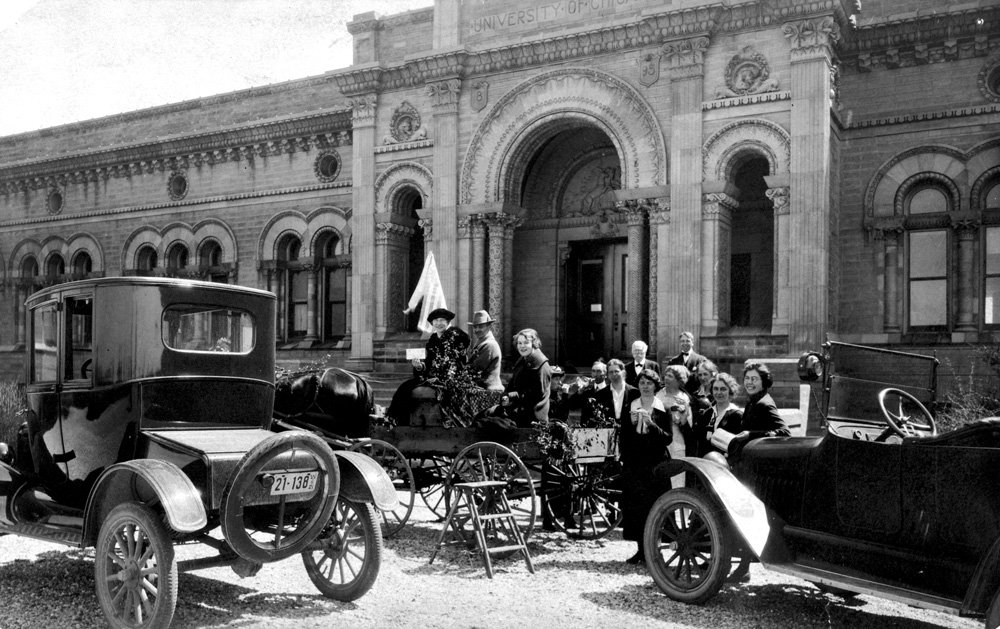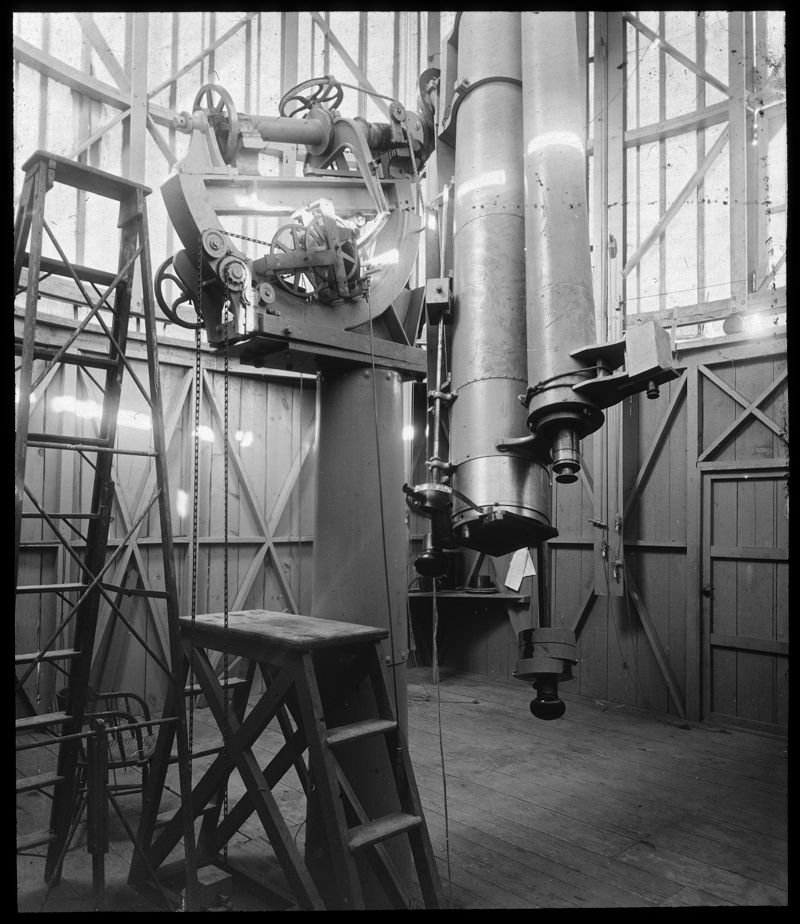Dorothy W. Block/Paraskevopoulos (1891-1967)
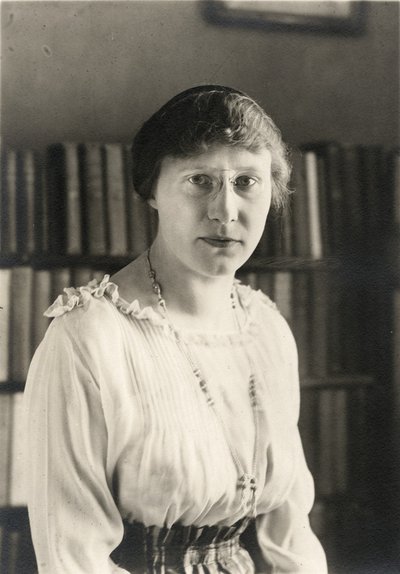
University of Chicago Photographic Archive, apf6-04180, Hanna Holborn Gray Special Collections Research Center, University of Chicago Library
http://photoarchive.lib.uchicago.edu/db.xqy?one=apf6-04180.xml
In the early 1920s Dorothy Block was determined to get a PhD. But she left Yerkes observatory when she got married — and spent the rest of her life working at observatories on three continents. This is the story of that remarkable woman.
Dorothy W. Block grew up in Brooklyn, NYC and attended the Girls’ High School at Halsey Street and Nostrand Avenue, graduating at the late age of twenty in 1911. [1 and Note] She obtained her BA from Hunter College in June 1915 and secured a temporary license to teach mathematics in elementary schools. [2] At this time she was also an active member of the Young People’s Baptist Union, leading meetings on topics such as "The Responsibility of our Society for Local, State, and National Unions” and “Christianity Compared with Other Religions” in 1916. [3]
After finishing her BA, Block worked as a laboratory assistant in the department of Astronomy at Hunter College and was an active member of the school’s popular astronomy club. She soon began studying at Columbia University and was the first woman at the University to pursue an MA in Astronomy. (The University had previously awarded PhDs to women.)
While studying at Columbia, Block was awarded the Maria Mitchell Memorial scholarship, which provided $500 to support research work at the Harvard College Observatory during the academic year 1917-1918. According to the annual report of the Maria Mitchell Association (established in 1902 order to support women in Astronomy): “The special task assigned to Miss Block was a photographic study of the variable star, Omicrom Ceti, the so-called Mira or Wonder-Star of the Whale.”
Block graduated with an MA from Columbia University in 1918 and began a new appointment as the Edward C. Pickering Fellow at Harvard College Observatory (HCO) in September for the 1918-1919 academic year. While at HCO, she measured the light of variable stars, the motion and position of several asteroids, as well as the Nova that appeared on June 8, 1918, in the constellation of Aquila. Block’s notebooks capture her work of this period.
Pursuing a position at Yerkes Observatory
In June 1919 Block wrote to Edwin Frost, the director of Yerkes Observatory, to ask about available positions at Yerkes for the next academic year.
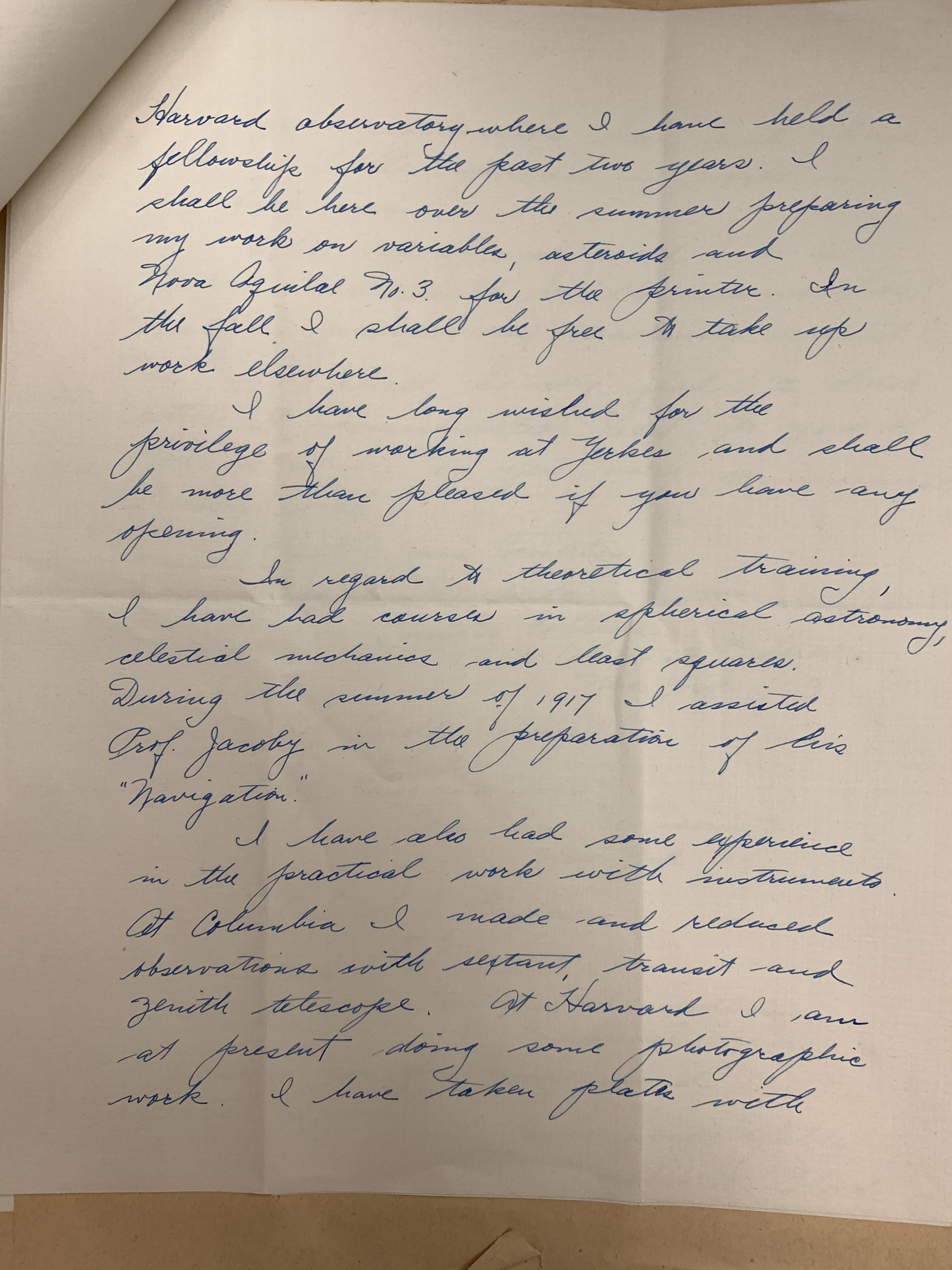
Dorothy W. Block to Edwin B. Frost, June 10, 1919. University of Chicago. Yerkes Observatory. Office of the Director. Records, [Box 76, Folder 4], Hanna Holborn Gray Special Collections Research Center, University of Chicago Library
"I have long wished for the privilege of working at Yerkes and shall be more than pleased if you have any opening.
In regard to theoretical training, I have had courses in spherical astronomy, celestial mechanics, and least squares. During the summer of 1917 I assisted Prof. Jacoby in the preparation of his “Navigation.”
I have also had some experience in the practical work with instruments. At Columbia I made and reduced observations with sextant, transit and zenith telescope. At Harvard I am at present doing some photographic work. I have taken plates..."
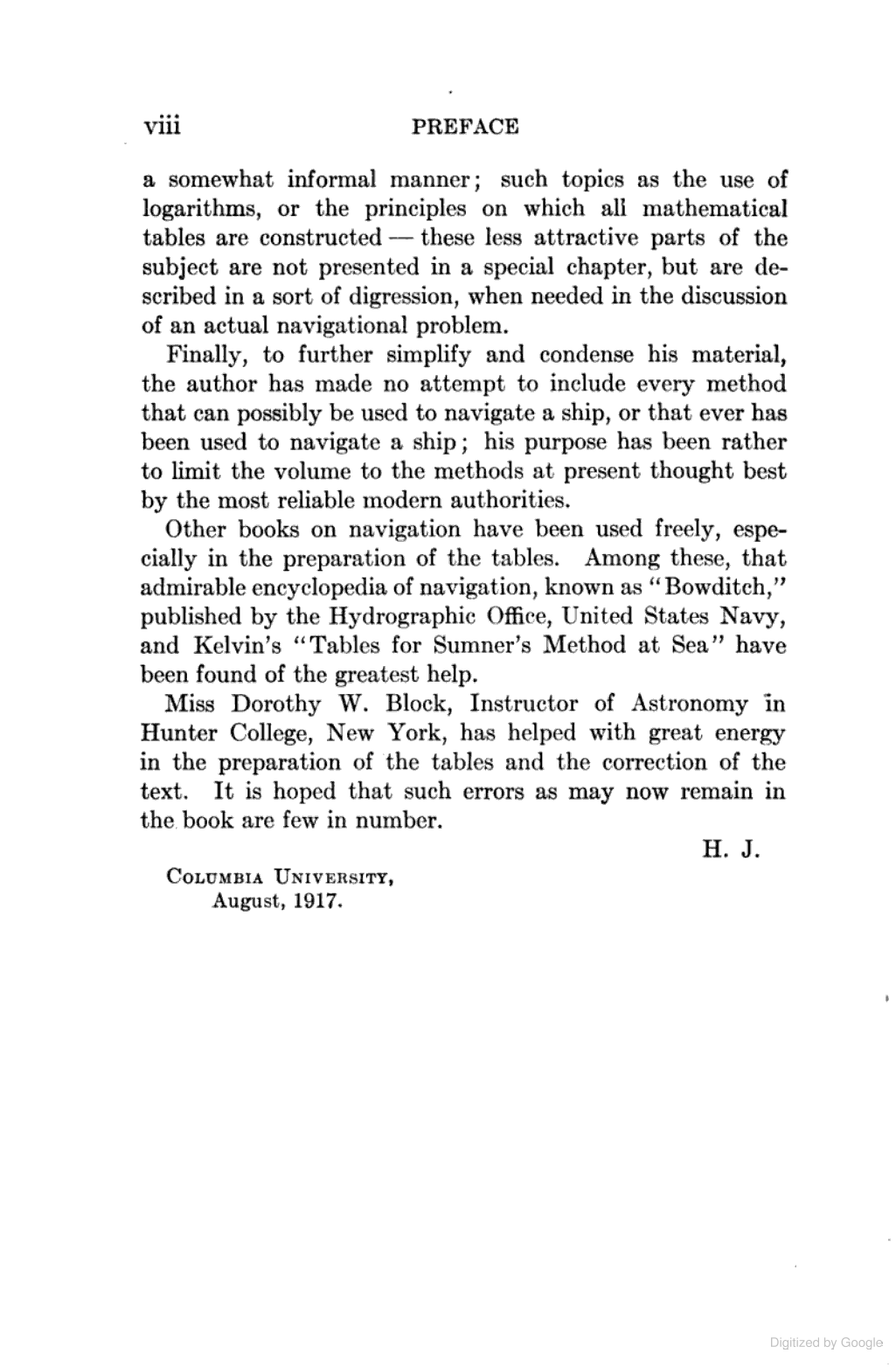
Jacoby, Harold. Navigation. Macmillan, 1917. p.viii
Block's contributions to Navigation were acknowledged by Jacoby: "Miss Dorothy W. Block, Instructor of Astronomy in Hunter College, New York, has helped with great energy in the preparation of the tables and the correction of the text. It is hoped that such errors as may now remain in the book are few in number."
Frost replied that a position would available that fall in the department of stellar spectroscopy, analyzing the light emitted from stars to learn about their physical characteristics and chemical composition.
"[The work] consists in measuring spectrograms and in working with the large telescope and the Bruce spectrograph, in securing them. The person who receives this appointment is registered as a graduate student at the University of Chicago and receives credit for such portion of her work as may properly be regarded as a part of her educational training... There are also involved certain duties as to meteorological observations, and in assisting in showing visitors about on certain occasions."
Frost then wrote to two of the six references she provided, asking “How do you think [Miss Dorothy W. Block] would do here for an assistant in stellar spectroscopic work, which involves both working with the big telescope and measuring spectrograms. It therefore takes a very responsible person, as there are times when she has to be alone in the big dome.”
And Jacoby replied: “I think Miss Block would do very well anything she undertakes. She made a good record at Harvard and also with me. She has just the right personality, and her astron[omical] Work is done for love of it, for she could get more pay teaching.”
How do you think [Miss Dorothy W. Block] would do here for an assistant in stellar spectroscopic work, which involves both working with the big telescope and measuring spectrograms. It therefore takes a very responsible person, as there are times when she has to be alone in the big dome.
Harold Jacoby to Edwin Frost, June 17, 1919. University of Chicago. Yerkes Observatory. Office of the Director. Records, [Box 77, Folder 2], Hanna Holborn Gray Special Collections Research Center, University of Chicago Library
Jacoby provided a strong recommendation for Block to Frost.
Block was enthusiastic about the position:
"I am greatly interested in the plan of work outlined and shall be glad to have you consider me as an applicant for the position.
An arrangement by which I receive academic credit is exactly what I want, as I wish to obtain my Doctor’s degree as soon as possible. Also I have a keen desire for greater opportunity in the handling of instruments. "
There was a delay in extending an official offer. She wrote again to Frost, worried that her earlier letter had been lost. Frost explained there had been two other applicants for the position – both men – and Frost had needed to wait to learn if either of them wanted the job. On one hand, this emphasizes the disadvantages faced by women in astronomy, since she was offered the position only after the male applicants withdrew from consideration, although she may have been the best, most qualified, or most deserving candidate. But on the other hand, this confirms that Block’s position at Yerkes was not gendered and she would be doing the work of an astronomer.
Dorothy Block, Astronomer
Block’s status as an astronomer was reinforced by Frost in correspondence with the University of Chicago soon after she arrived at Yerkes in September 1919. The University had mistakenly classified her as a “Computer” and Frost was displeased. As he explained in a letter to the University administration:
"Miss Dorothy W. Block has shown me a recent letter from you. I had recommended to the President that she be appointed Assistant for Stellar Spectroscopy. I prefer this title to that of computer (although she is paid from the Computers fund) because she will be intrusted [sic] with the responsibility of observing with the 40-inch telescope. It seems proper that such a distinction should be made. I presume that there was no intention on the part of the President that she should not be appointed Assistant for Stellar Spectroscopy. … would you be kind enough to have the necessary steps taken to name her as Assistant, as above stated."
I prefer this title to that of computer (although she is paid from the Computers fund) because she will be intrusted with the responsibility of observing with the 40-inch telescope.
This error was quickly corrected. Block was not employed by Yerkes to fulfill a specific task – that of calculating – she was at the Observatory as a graduate student and an astronomer in training. And this was certainly how she saw herself. In the 1920 census she listed her occupation as “Astronomer” and she would continue to do so for the rest of her life.
UK and Ireland, Incoming Passenger Lists, 1878-1960 [record accessible via Ancestry here].
Block/Paraskevopoulos's profession is listed as “Astronomer” on documents from 17 Oct 1932 when she travelled to London with her mother, on route back to South Africa from a visit to the United States.
Yet Block never completed her PhD. At Yerkes she met and married the Greek Astronomer John S. Paraskevopoulos. While for most women at this time marriage meant an end to their independent careers, given her future husband’s profession and nationality, marriage for Block held a unique opportunity. Long-established conventions prevented married women from employment at universities and new anti-nepotism rules reduced their official employment opportunities even further. However, as one half of an astronomical couple, she could continue doing scientific work, without the official status and formal recognition that the profession bestowed on her husband.
Block was faced with a choice. On one hand, she could marry, giving up the pursuit of her own PhD, but potentially gaining access to the Observatory in Athens to which her husband was to return. On the other hand, she could complete the PhD and seek employment at observatories or universities independently. Perhaps she was reminded of the time, less than one year before, when she awaited news of her application to Yerkes and of the fact that she received her appointment only because both men under consideration for the position dropped out. Perhaps she thought that a life devoted to observatory research as one half of an astronomical couple was more appealing than facing the job market given the very limited employment prospects of women in astronomy – even those with a PhD. Perhaps she was just in love. Ultimately, she chose marriage and – though she did not know it at the time – a life of astronomical exploration that would span four continents.
University of Chicago Photographic Archive, [apf6-00429], Hanna Holborn Gray Special Collections Research Center, University of Chicago Library.
Engagement party of Dorothy W. Block and Dr. John S. Paraskevopoulos attended by the Yerkes Observatory staff. Block is seated in the front of the wagon.
Life after Yerkes
Dorothy and John Paraskevopoulos departed for Greece in September 1921. And here, indeed, she continued her work. As reported in 1922 by the annual report of the Maria Mitchell Association (which kept good track of its alumnae), “Mrs. Paraskevopoulos is continuing her astronomical work in Athens, together with her husband who is Astronomer at the National Observatory of Greece.” Block/Paraskevopoulos and her husband became dissatisfied with the material conditions of the Athens observatory, which lacked the more modern astronomical equipment available to them in the United States.
As John Pareskevopoulos wrote to Yerkes Director Edwin Frost in 1923,
"There is absolutely no prospect of having a good modern instrument here. After all the opportunities I had at American Observatories, working with the best instruments, I feel that one must be an idiot indeed, to be contented with the title of astronomer of the Greek observatory, knowing that he must do work, which was modern fifty years ago. "[4]
He and Block/Paraskevopoulos were consequently eager to find him a new position.
In the meantime, Harlow Shapley was seeking an astronomer to assume responsibility for Harvard's Southern Hemisphere observatory operations.[5] Frost provided a reference which not only addressed Shapley’s questions about John’s abilities, but also highlighted Dorothy’s own astronomical competencies.
"He observed with the 40-inch with the spectrograph regularly for a considerable period, as did his wife, then Miss Block. They are both very anxious to get into active work which they do not feel is possible with the equipment at Athens, and I feel that they might serve you very well at Arequipa... I think that on the whole you would be very fortunate if you get Mr. And Mrs. Paraskevopoulos to take up the Arequipa work and, owing to the conditions in Greece, I presume they would be glad to go." [6]
On the whole you would be very fortunate if you get Mr. And Mrs. Paraskevopoulos to take up the Arequipa work...
Dorothy Block/Paraskevopoulos and her husband consequently did not remain in Greece for very long. For John was soon appointed to direct the Harvard College Observatory’s Southern Station in Arequipa, Peru. He would replace Prof. Solon Irving Bailey, who had not only been responsible for establishing and running the Arequipa station since 1889, but who had also been one of Block’s references when she first applied for a position at Yerkes.
As an astronomical couple, when Paraskevopoulos' career advanced, so too did Block/Paraskevopoulos' opportunity for continued research. Again, the Maria Mitchell Association emphasized this fact, reporting in 1924 that: "Besides presiding over the Observatory House, which is a visiting place for tourists of all nations, Mrs. Paraskévopoulos is also a regular member of the staff, assisting with the photographic telescopes and making visual observations of southern variable stars.”
These observations appeared frequently in the Harvard College Observatory Bulletin between 1925 and 1928, although only one “Magnitudes of Nova Pictoris” (1926) listed her as the author. The rest, all eleven of them, were published with only Paraskevopoulos’ name listed as author.
Further evidence of involvement in the research activities of Arequipa Station can be found in the official correspondence that she sent back to Harvard. The letters from September 1923 to August 1924 are accessible online in the Harvard University Archive, and they demonstrate the extent to which Block/Paraskevopoulos not only managed the operations of the Observatory, but also actively contributed to astronomical research.
Paraskevopoulos' letters refer to her working with both the 10-inch and 13-inch telescopes while also noting more specific discoveries as when he reported that, “the data given below is for two variables discovered by Mrs. P… Besides these Mrs. P. has found two faint objects… We have received 33 variable star charts which Mrs. P has incorporated in her program for work with the 5[-inch telescope].”
13 inch Boyden refractor, Harvard College Observatory, Arequipa, Peru (between 1891-1911). John G. Wolbach Library, Harvard-Smithsonian Center for Astrophysics
As part of her role at the Observatory in Arequipa, Dorothy Block Paraskevopoulos observed using this telescope.
In another letter Paraskevopoulos wrote to Shapley stating, “Mrs. P. suggests that she would like to photographically follow up a few variable stars given as “Unbekant” [unknown] in the “Viertelschrift der Astronomischen Gesellschaft” [Quarterly Publication of the Astronomical Society] to determine their elements.” He then tactfully asked, “Do you think it would be worthwhile to give enough time with the new 3’’ [i.e., 3-inch telescope] to get three or four such regions each week in addition to the regular patrol program?” Tactfully, because this was less of a scientific question than it was an economic one. The resources she needed to conduct this research would have to come out of the materials paid for by the Harvard Observatory for the work they were carrying out on its behalf. Shapley seems to have deemed the work worthwhile, for while his reply is not available, Paraskevopoulos reported “Dorothy is moving forward with her work on the ‘unbekannts’ [sic] (unknowns)” two months later.
Block/Paraskevopoulos was also the Observatory’s true managing director, and her husband gave her full credit for this work. As he explained to Shapley in October 1924, towards the end of their first year in charge of the Arequipa Observatory, “I am glad you like the form of the budget and annual financial report. Mrs. P is responsible for it.” And on top of this, Block/Paraskevopoulos assumed many of her husband's duties whenever he had to travel. When he journeyed to Chile to explore an alternate site for the Harvard Southern Station at the very beginning of their tenure, Paraskevopoulos explains in a letter to Shapley , “we have arranged that upon Prof. Bailey’s departure she is to assume my duties here. She will begin regular work Nov. 15.” And work she did. Since the weather made it difficult to make observations and take photographic plates during this time, Block/Paraskevopoulos “systematized” the offices and the library, created a card catalogue for the Observatory Library, oversaw the repair of the 5-inch visual telescope, and saw to it that the telescope’s building was not just repaired but also remodeled.
In her correspondence with Shapley during this period, Block/Paraskevopoulos’ independence and autonomy as an astronomer are clearly on display, yet so too is the assumption of her vulnerability due to her gender. As she wrote in her first letter as acting Director of the Station, “I have been alone for several days now, but so far no one has stolen our “silver.” However, Prof. Bailey left me the observatory revolver with which to protect myself in an emergency.”
Arequipa was not, however, an ideal site for an astronomical observatory. The advantages of its mountain location were offset by an extended cloudy season, which made observing difficult from December to April. And the other sites explored by Paraskevopoulos in South America were little better. The station was relocated in its entirety from Peru to Bloemfontein, South Africa, beginning in 1927, with the Paraskevopoulos partnership continuing their work. Providing another update on her in 1935, the Maria Mitchell Association accurately observed that Dorothy Block Paraskevopoulos “has been an observer and an astronomical assistant to her husband ever since her marriage.” While the role of "assistant" is used for historically understandable, we believe that she was a talented yet under recognized astronomer of the early twentieth century in her own right.
NOTE: Names for women during the time they are unmarried use their family or birth last name; references to the women in the time following a marriage use the convention "unmarried last name/married last name," e.g., Block/Paraskevopoulos. [back]
[1] “Kick at Coronation in School Speech, Sup’t Shallow Pities Americans who Wept at the Function, Fine time at Girls’ High, Miss Marcus the Brightest Pupil in a Splendid Lot of Graduates,” The Brooklyn Times (via newspapers.com, there listed as/called: Times Union [Brooklyn, New York]) (via newspapers.com – HERE). [back]
[2] Per BA Graduation: “Our girls Win Prizes, Presented Today at Hunter College Commencement,” The Brooklyn Daily Eagle (Thursday, June 15, 1915): 23 (via newspapers.com – HERE). Per teaching license: “Elementary School Promotions,” The Brooklyn Daily Times (Thursday, August 12, 1915): 3 (via newspapers.com – HERE). [back]
[3] Per the first topic: “First Baptist Church,” The Chat (Brooklyn, New York) (Saturday, October 30, 1915): 53 (via newspapers.com – HERE). Per the second: “First Baptist Church,” The Chat (Brooklyn, New York) (Saturday, October 21, 1916): 52 (via newspapers.com – HERE). [back]
[4] John Paraskevopoulos to Edwin Frost, April 25, 1923. University of Chicago. Yerkes Observatory. Office of the Director. Records, [Box 94, Folder 1], Hanna Holborn Gray Special Collections Research Center, University of Chicago Library. [back]
[5] Harlow Shapley to Edwin Frost, May 19, 1923. University of Chicago. Yerkes Observatory. Office of the Director. Records, [Box 94, Folder 6], Hanna Holborn Gray Special Collections Research Center, University of Chicago Library. [back]
[6] Edwin Frost to Harlow Shapley, May 22, 1923. University of Chicago. Yerkes Observatory. Office of the Director. Records, [Box 94, Folder 6], Hanna Holborn Gray Special Collections Research Center, University of Chicago Library. [back]
